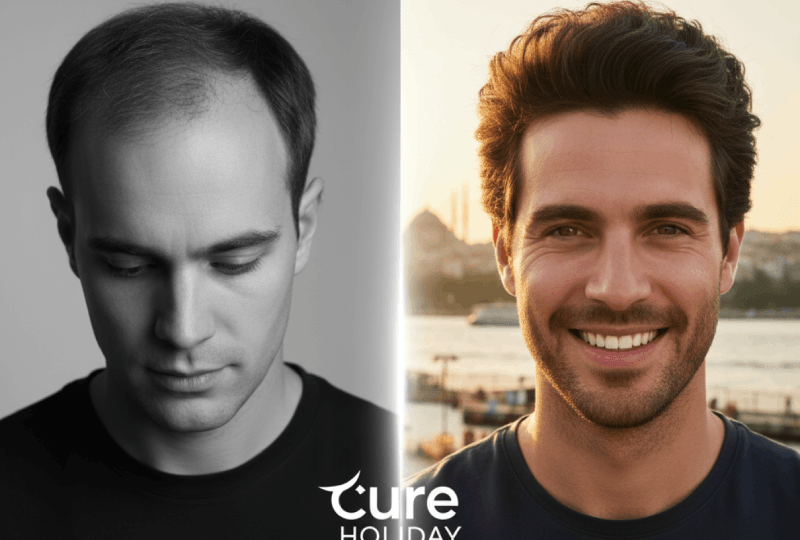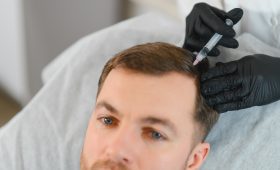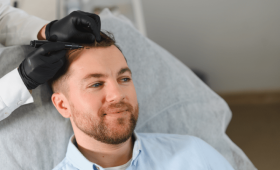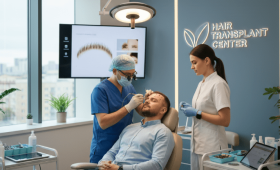I. Introduction: The Concept and Importance of the Donor Area
Hair transplantation is essentially a procedure in which a person’s own hair follicles (grafts), which are genetically resistant to balding, are moved from one area of the body to another, typically a bald or thinning area. The success of this operation largely depends on the quality and genetic characteristics of the “donor area” from which the grafts are harvested. The donor area is not just one stage of the hair transplant operation; it is a critical prerequisite that directly determines the permanence and natural appearance of the transplanted hair.
In medical literature, the donor area is referred to as the “Safe Donor Area” (SDA). This term covers the back and sides of the head, which are genetically insensitive to the dihydrotestosterone (DHT) hormone that causes balding. This is the fundamental scientific principle behind the lasting results of a hair transplant operation. Hair follicles retain their genetic programming, maintaining their resistance to balding in their new location. Therefore, the selection of the donor area transforms the success of the operation from a matter of chance into a predictable process based on biological and genetic principles. For this reason, the first and most vital step of the operation is the correct identification and evaluation of the donor area from which the hair follicles can be harvested efficiently and healthily.
II. The Traditional and Most Preferred Donor Area: Nape and Temples
Anatomical and Genetic Superiority of the Nape Area
The back of the head and the nape area between the two ears are considered the most ideal donor source for hair transplantation. The hair follicles in these regions show the highest genetic resistance to the hormones that cause balding. Known in medical terms as the “safe donor area,” this region is key to a permanent hair transplant result. The “Safe Donor Area” (SDA) as defined by Unger includes the parietal and occipital regions and is suitable for approximately 80% of patients under the age of 80. The density of this area is determined by a trichogram analysis based on individual characteristics.
Hair Characteristics and Graft Harvesting Capacity
The hair in the nape area provides the best structural and aesthetic match with the existing hair in the recipient area. A healthy donor area should have a minimum density of 40 grafts per square centimeter (cm²) and 80 to 100 hair follicles per cm². An average hair transplant operation may require between 4000 and 6000 grafts. The nape area, with its high density and large surface area, is the most efficient area to meet this demand. If the capacity of this area is insufficient, it seriously jeopardizes the feasibility of a large-area hair transplant operation and necessitates the use of alternative donor areas.
Graft Harvesting Techniques
Graft harvesting from the traditional nape donor area is performed using the FUE (Follicular Unit Extraction) method. In this technique, hair follicles are harvested one by one using a micromotor or a manual punch device. The fact that FUE, unlike the older FUT (Follicular Unit Transplantation) method, does not leave a permanent linear scar in the donor area has made it popular. Grafts are harvested with an appropriate punch diameter (e.g., 0.5 mm) and are stored in special solutions until transplantation.
III. Alternative Donor Areas: Body Hair Transplantation (BHT)
Necessity and Application Areas of BHT
In cases where the donor area on the scalp is insufficient (e.g., in completely bald individuals) or when a higher density is desired, an alternative method called Body Hair Transplantation (BHT) comes into play. BHT typically involves harvesting grafts from different parts of the body using the FUE technique.
The Closest Alternative to Nape Hair: The Beard Area
The beard area is the alternative donor area with characteristics most similar to nape hair. Beard hairs have a thicker and coarser structure than nape hairs; their average diameter is between 0.08 and 0.1 mm, whereas a head hair strand is 0.04-0.06 mm. Beard grafts usually contain a single hair follicle. It is the closest to hair follicles in terms of its growth cycle, and there is a high probability of it adapting to the transplanted area and showing resistance to balding. From the beard area, 500 to 1500 grafts, and even up to 3000 grafts in individuals with a dense beard, can be harvested. These hairs are ideal for providing volume and density, especially in the vertex area. They also allow for a fuller and more homogeneous result when used together with nape hair. For patients who complain about excessive density in the beard area, it also provides the advantage of regional thinning.
Other Body Hairs: Chest, Back, and Leg Hairs
Hairs from the chest, back, legs, and arms have a thinner, curlier, and weaker structure compared to beard and head hairs. The growth cycle of these hairs is different from and slower than that of head hair; for example, chest hairs can grow up to a maximum of 6 cm. These structural differences lead to lower survival rates after transplantation and require careful planning of the final aesthetic outcome. These areas are generally used as a last resort for situations with limited graft needs or for revision surgeries. For a natural look, it is preferred to mix these hairs homogeneously with follicles harvested from the scalp rather than implanting them alone.
Aesthetic Principles of BHT
Hair transplantation from body hairs not only increases the number of grafts but also introduces factors that complicate the aesthetic results. The different growth cycles, growth rates, textures, and thickness of body hairs can lead to an unnatural appearance if not planned correctly. For example, implanting thick beard hairs into the frontal hairline can cause an artificial look. This situation shows that donor area selection is not limited to the number of grafts, but that the morphological characteristics of the grafts also directly determine the transplantation strategy and the final aesthetic appearance. Therefore, the success of a BHT operation depends on the experience of the specialist performing the procedure, their ability to plan correctly, and their ability to manage the patient’s expectations.
IV. Detailed Examination of Graft Harvesting Techniques from the Donor Area
Applied Techniques
The primary technique used for graft harvesting from the donor area is FUE. The FUE method is a minimally invasive approach where hair follicles are harvested one by one with a micromotor or manual punch device. After harvesting, the grafts are transferred to the recipient area. In the DHI (Direct Hair Implantation) technique, the grafts are placed directly into the recipient area with a Choi implanter pen without the need to open channels first. In both techniques, it is of critical importance to use punch diameters appropriate for the thickness of the hair follicles during graft harvesting.
Importance of Specialist Experience in Graft Harvesting
The graft harvesting process requires great surgical precision. Inexperienced hands can lead to graft loss and visible scarring in the donor area if attention is not paid to the direction and angle of the hair follicles. A professional graft harvesting process from the donor area does not involve harvesting grafts side by side, which ensures minimal thinning in the donor area. In a reliable clinic, the possibility of scarring in the donor area is almost non-existent with a homogeneous graft harvest.
V. The Donor Area After Surgery: Healing and Management
Healing Process and Possible Side Effects
After a hair transplant operation, the donor area typically begins to heal within 3-7 days. This process is characterized by symptoms such as mild pain, swelling, redness, and scabbing in the area. These symptoms are considered a normal part of the body’s healing process and usually resolve on their own within a few days to a week. Grafts harvested from the beard area heal faster due to the shorter distance under the skin (2 mm vs. 3-4 mm for hair follicles).
Potential Risks and Complications
Even with the modern FUE technique, it is inevitable for micro-scars smaller than 1 mm to remain in the donor area. Furthermore, if a sufficient number of hair follicles are not left behind or due to over-harvesting, thinning can occur in the donor area. Operations performed in non-sterile conditions increase the risk of rare and serious complications such as infection, loss of sensation, necrosis (tissue death), and keloids. A fast and smooth healing process is evidence that the procedure was performed with the correct techniques, appropriate punch diameters, and by an experienced specialist. Unexpected symptoms such as persistent pain, swelling, or fever may be signs of an underlying complication and should be immediately reported to a doctor.
Measures to Support the Healing Process
Proper care of the donor area after the operation is vital to support the healing process and minimize risks. Patients should regularly use the medications, shampoos, and creams recommended by their doctor, avoid alcohol and smoking, and protect the treated area from scratching and trauma.
VI. Comparative Analysis and Patient Assessment
The selection of the donor area in hair transplantation is a complex decision that must be personalized according to the patient’s hair loss type (Norwood scale), the capacity of the existing donor area, and their aesthetic expectations. Donor areas consisting of the nape, beard, and other body hairs offer different advantages and limitations. The table below provides a comparative overview of the critical features of these areas:
| Criterion | Nape and Temples | Beard Area | Chest and Other Body Hairs |
| Primary Use | Large area transplantation, natural appearance, permanent hair source | Volume increase, vertex area densification | Alternative source, revision, limited transplantation |
| Hair Structure (Thickness, Shape) | Normal thickness (0.04-0.06 mm), straight | Thick (0.08-0.1 mm), coarse | Thin and curly |
| Hair per Graft | 1-4 hairs/graft | Usually 1 hair/graft | 1-2 hairs/graft (Predicted) |
| Growth Cycle | Long anagen phase, DHT resistant | Growth cycle closest to head hair, DHT resistant | Different from head hair, slower growth |
| Post-Op Healing | 3-7 days , mild pain/swelling | Very fast, 1 week , 2 mm under-skin distance | Rapid scabbing, 10 days |
| Aesthetic Result | High naturalness, volume, and direction | High density, suitable for the vertex, must be used carefully on the hairline | Natural appearance only in combination |
| Potential Risks | Thinning, scarring | Low risk of scarring, experience is important | Low survival rate, unnatural appearance |
This comparative analysis clearly shows that the nape donor is always the first and most ideal choice. However, for patients with insufficient donor capacity, the beard and body hairs offer critical additional resources. The final decision should be made jointly based on the patient’s expectations, a scientific analysis of the donor area, and the guidance of an experienced specialist.
VII. Conclusion and Expert Recommendations
This report reveals that the donor area in hair transplantation is more than just a source of grafts; it is one of the most important factors that directly affects the permanent success of the operation, its aesthetic results, and the healing process. The lasting success of a hair transplant relies on the nape and temple areas, which are genetically resistant to balding. When the nape donor is insufficient, the beard and other body hairs (BHT) offer an alternative solution. However, the unique hair characteristics and growth cycles of each donor area demonstrate that the transplantation strategy must be personalized and planned carefully.
The success of this comprehensive medical procedure depends on the meticulous analysis of the donor area, the selection of the correct graft harvesting technique, and the care shown during the post-operative recovery period. It is essential for patients to view this process not just as an aesthetic procedure but as a comprehensive healthcare decision that requires scientific knowledge, surgical precision, and aesthetic planning. Since donor area capacity is one of the most determining factors, patients must first consult with a specialist who is experienced and expert in the field to get a proper analysis and discuss all alternatives and risks in detail. In expert hands, even patients with the most limited donor capacity can achieve satisfactory and natural results.
Unlocking Your Confidence with a Hair Transplant in Turkey: An Exclusive Offer from Cure Holiday
Have you been thinking about getting your hair back, but you’re not sure where to start? A hair transplant can be a life-changing experience, and Turkey has become the number one destination for this popular cosmetic procedure. With advanced techniques and experienced surgeons, it’s easier and more affordable than ever to restore your hair and your confidence.
At Cure Holiday, we specialize in making this journey simple, safe, and stress-free. We believe that everyone deserves to feel their best, and our all-inclusive packages are designed to give you a premium experience without the premium price tag.
Why Choose Cure Holiday?
- Experienced Doctors: Our partner clinics work with some of Turkey’s most skilled and reputable surgeons, ensuring you’re in expert hands from start to finish.
- All-Inclusive Comfort: Forget about the hassle of planning. Our packages cover everything: your flights, 5-star hotel stay, airport transfers, and even a dedicated host to guide you through every step of your treatment.
- Cutting-Edge Techniques: We offer the latest hair transplant methods, including FUE (Follicular Unit Extraction) and DHI (Direct Hair Implantation), giving you natural, permanent results with minimal scarring.
- Unbeatable Value: Thanks to Turkey’s lower operational costs, we can provide world-class quality at a fraction of the price you’d pay in the UK, USA, or Europe.
Your New Look is Closer Than You Think
Ready to take the first step toward a new you? Contact us today for a free consultation. Our team is here to answer all your questions and help you customize a plan that’s perfect for you.
Don’t let another day go by wishing for the hair you used to have. Let Cure Holiday help you get it back, with an exclusive offer you won’t find anywhere else.



